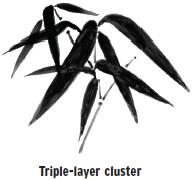Chinese Brush Painting (16 page)
Read Chinese Brush Painting Online
Authors: Caroline Self,Susan Self

Painting Leaf Clusters
Now that you have the feel of the brush for a straight stroke, try making strokes going left and right, as in the examples below.
After you can make strokes right and left, plan the leaves to make a cluster. No two leaves should be exactly the same size or point in the same direction. The spaces between the leaves should also be different. The sequence for placing the leaves is the same as in calligraphy: Do the center, then the left, then the right, then left and right again.

1.
Load the large brush and tap off the excess.
2.
Stroke 1.
Touch the brush near the center of the leaf area of the painting, press, drag, and lift little by little, moving slightly to the right so the stroke will not be vertical. This is the host leaf, the largest one in the cluster.
3.
Stroke 2.
Make a second, smaller stroke toward the left, leaving a wide space from the first stroke.
4.
Stroke 3.
Make the third stroke to the right of the main one. Start it close to the main and go to the right.
5.
Stroke 4.
Make the fourth stroke start very near the main and swing to the left, almost horizontal.
6.
Stroke 5.
If there is a fifth stroke, make it come off the top of the cluster as if it is going straight out the back of the cluster of leaves.
Try making different clusters of leaves your own way so that the final picture will have variety. Decide on three different clusters for your picture.
Other Ways to Paint Leaves
After you have practiced painting the basic stalks and leaf clusters, you can try painting them in different ways.
Painting Cross-Over Leaves
In painting orchid, the Buddha’s eye adds interest to the leaf design. In painting bamboo, crossing a leaf over another within a bamboo leaf cluster also adds interest. Practice painting cross-over leaf patterns like the ones shown below. Do not paint the cross-over leaf until the lower leaf is slightly dry. Otherwise, both leaves will blur.

Painting Many-Layer Clusters
A cluster can seem to have many layers going back in space. To create this effect, you paint a layer of larger leaves in front, a layer of smaller leaves behind that, and a layer of even smaller leaves behind or above that. Leaves painted with lighter paint also seem to be further back in space than the strong, dark leaves at the front.
Whenever you paint many layers of leaves, paint the large leaves first, let them dry slightly, paint the smaller leaves, let them dry slightly; and last, paint the smallest leaves at the back.
Can you find the three layers?

Painting Dry Brush Stalks
One way to paint bamboo stalks is to use a dry brush with dark paint to make the bone strokes. The dry brush makes stripes that represent the fibers of the bamboo. The white areas defined by the strokes are called “flying white.”

1.
Load the large brush with the medium mix. Lay the brush against the paper towel to get out some of the moisture. Stroke the brush on the towel to see if it is still too wet.
2.
Start the vertical bone stroke for a stalk section to see if you can produce flying white.
3.
Keep practicing to get the right amount of moisture to create the effect.
Painting Rounded Stalks
Shading one side of the bamboo stalk makes it look rounded.






